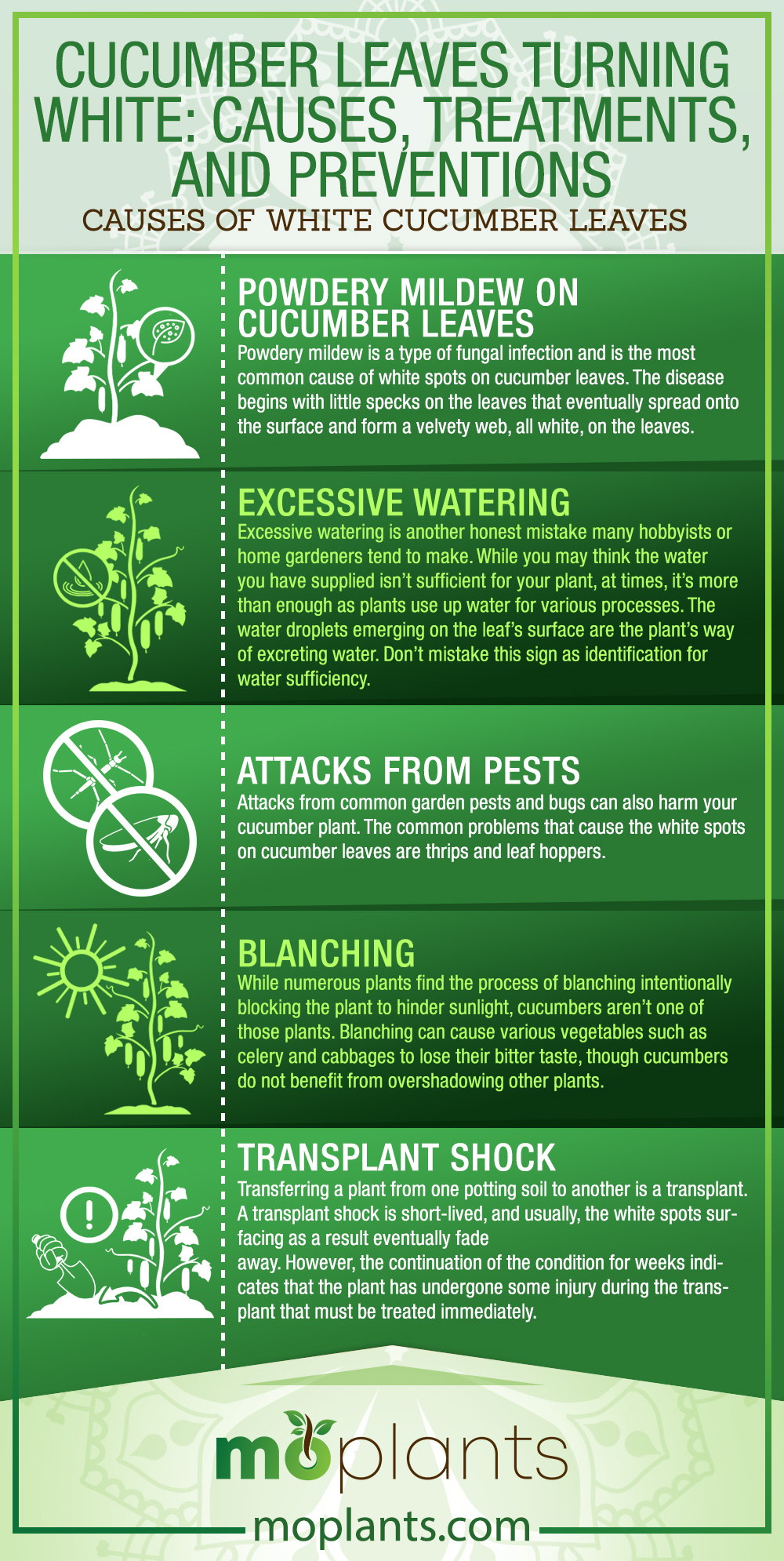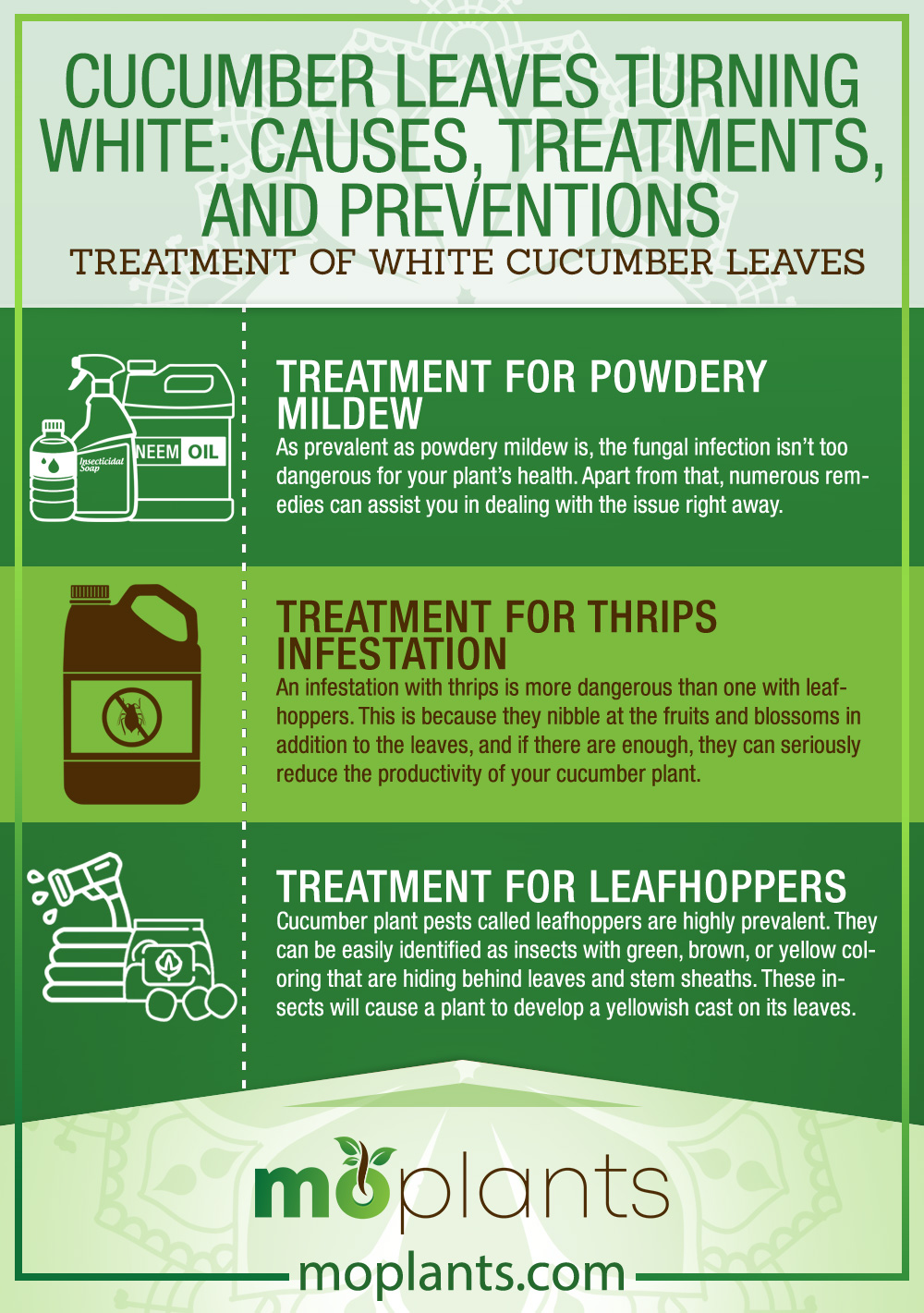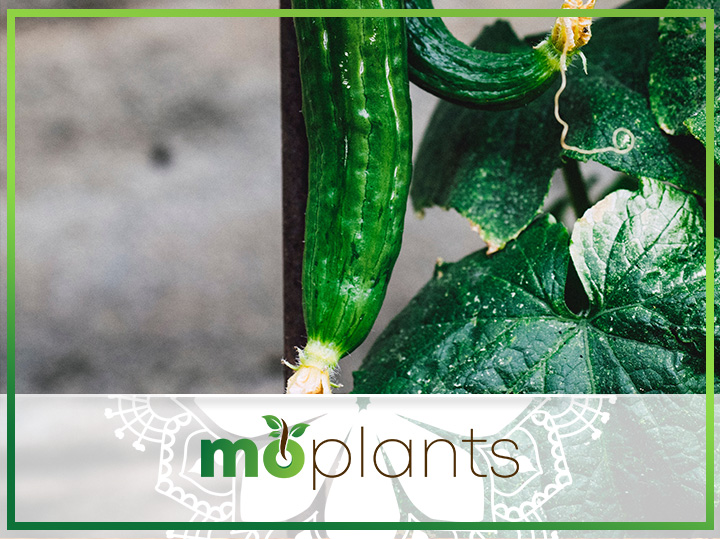Cucumbers are considered one of the primary ways of eating your water. What’s fun about this vegetable is that it can be grown in your backyard. You need to take care of these juicy and valuable plants as they can quickly develop spots on their leaves.
White spots on cucumber leaves are an ordinary issue hobbyists face. However, in-depth knowledge of the causes of these white spots can help identify the correct treatment for the issue and the preventive measures necessary to prevent the situation from recurring.
Causes of White Cucumber Leaves
For several reasons, your healthy cucumber plant can suddenly develop white spots on the leaves or turn white altogether. Growth of powdery mildew on cucumber leaves, excessive watering of the plant, attacks from pests, insufficient sunlight, and transplant shocks are some of the reasons why your cucumber leaves are losing their color or developing an unhealthy condition.
Powdery Mildew on Cucumber Leaves
Powdery mildew is a type of fungal infection and is the most common cause of white spots on cucumber leaves. The disease begins with little specks on the leaves that eventually spread onto the surface and form a velvety web, all white, on the leaves. While the condition isn’t too dangerous and can be observed on various other plants and crops, getting rid of the fungus as soon as possible is essential to stop it from propagating to other plants.
Apart from that, if the hyphae cover the leaf’s surface entirely, the process of photosynthesis hinders, causing the plant to gradually wilt and die. You may observe your cucumber plant leaves slowly curling and discoloring. If it comes to such a point, you can treat the plants in numerous ways, which we’ll discuss later in the article.
Excessive Watering
Excessive watering is another honest mistake many hobbyists or home gardeners tend to make. While you may think the water you have supplied isn’t sufficient for your plant, at times, it’s more than enough as plants use up water for various processes. The water droplets emerging on the leaf’s surface are the plant’s way of excreting water. Don’t mistake this sign as identification for water sufficiency.
Too much water depletes nutrition and makes the leaves swell. The leaves then become drab and white.
Attacks from Pests
Attacks from common garden pests and bugs can also harm your cucumber plant. The common problems that cause the white spots on cucumber leaves are thrips and leaf hoppers.
Thrips:
These tiny bugs tend to eat up leaves and leave a silvery web-like pattern behind. The formation of a silvery white pattern, also called rasping, is evident on the leaf’s upper surface. In the case of thrips, their black droppings indicate their infestation.
Leafhoppers:
Leafhoppers are another common pests that suck the leaf’s sap, sucking away all the nutrients the leaves need to stay alive and healthy. The pests leave behind white spots and blotches that cause the leaves to turn white, dry up, curl and eventually fall.
Insufficient Sunlight
Plants undergo the process of photosynthesis to prepare food for themselves. The process requires sunlight that plants consume as fuel. Insufficient sun exposure might also cause the leaves of your cucumber plant to become white. The amount of chlorophyll in the leaves (the chemical responsible for making food) will diminish if they do not receive enough sunshine. They will consequently appear white or grayish as a result.
Blanching
While numerous plants find the process of blanching intentionally blocking the plant to hinder sunlight, cucumbers aren’t one of those plants. Blanching can cause various vegetables such as celery and cabbages to lose their bitter taste, though cucumbers do not benefit from overshadowing other plants.
Cucumbers must be in an area where they can get enough sunlight. Insufficient sunlight can cause the leaves to lose their chlorophyll and natural green pigmentation, eventually turning white.
Transplant Shock
Transferring a plant from one potting soil to another is a transplant. A transplant shock is short-lived, and usually, the white spots surfacing as a result eventually fade away. However, the continuation of the condition for weeks indicates that the plant has undergone some injury during the transplant that must be treated immediately.
Infographic

Treatment of White Cucumber Leaves
Once you have identified what caused the white spots on cucumber leaves, you can select one of the treatment methods listed below to bring your plant back to health.
Treatment for Powdery Mildew
As prevalent as powdery mildew is, the fungal infection isn’t too dangerous for your plant’s health. Apart from that, numerous remedies can assist you in dealing with the issue right away.
Antifungal Sprays
You may get rid of the white powder on your cucumber leaves resulting from the fungus by spraying your mildew-affected plant with a potent fungicide.
Neem Oil
When it comes to treating mildew, neem oil is also efficient. You may readily find it at your neighborhood general shop. Use only a few drops while applying it with a cotton roll straight to the white patches.
Neem oil can also be sprayed on the damaged plant after being combined with water or milk. The white spots on cucumber leaves won’t go away until you do this once a week for a few months.
The Mixture of Soap and Sodium Bicarbonate
One tablespoon of ordinary soap and one tablespoon of baking soda should be combined. Spray until the entire plant, and its soil is evenly moistened with this combination after adding one gallon of water. Your plant will recover quickly.
Vinegar
Vinegar is a typical household item that you can use to treat mildew infections in your home. Just three teaspoons of vinegar should be added to a gallon of water. Once each day, lightly mist your plants with this combination.
You risk burning your plant if you use too much vinegar or spray this mixture too frequently. In a few weeks, your plant will start showing improvement.
The Mixture of Milk and Water
Low-fat milk functions as a strong natural antibacterial and antifungal. Spray the plant with a solution made by using 1:9 parts water to 1 part skim milk. You should start noticing changes in a few weeks.
Treatment for Thrips Infestation
An infestation with thrips is more dangerous than one with leafhoppers. This is because they nibble at the fruits and blossoms in addition to the leaves, and if there are enough, they can seriously reduce the productivity of your cucumber plant. Find out here how to get rid of them.
Remove them from the plant by hand if they are few and readily apparent. You can either use a water jet to wash them off or a cotton pellet to pull them off individually.
It’s also known that gently washing your plant with soap and water will reduce the number of thrips living there. In dire circumstances, you will have to use an insecticide. Always pick one that is gentle and not too severe for your plant.
Treatment for Leafhoppers
Cucumber plant pests called leafhoppers are highly prevalent. They can be easily identified as insects with green, brown, or yellow coloring that are hiding behind leaves and stem sheaths. These insects will cause a plant to develop a yellowish cast on its leaves.
They are relatively simple to eradicate. Simply physically remove them from your plant with a cotton roll or a water jet. They can also be eliminated by applying thick oil.
Infographic

Prevention of White Cucumber Leaves
Not all the reasons behind white spots on cucumber leaves can be treated. However, some require your utmost attention to prevent the issue from recurring. Here are some preventive measures you can take to prevent your cucumber plant leaves from turning white:
Avoid Watering Your Plant Excessively
A plant needs adequate water, just like every other organism. Excessive watering will cause your cucumber plant to wilt. Cucumber plants need to be watered only once a week.
Before the watering process, ensure that the plant’s soil is dry. To check that, insert a dry object into the ground. Let it sit for a couple of seconds, then remove it. Observe the inserted object for any water droplets or dampness. If you find the thing damp, avoid watering the plant as it has sufficient water.
Another rule of thumb is to always water near the stem and roots of the plant instead of watering the leaves. An entirely damp plant won’t only wilt faster but also invite other fungal diseases that can harm the leaves or soil.
Ensure Your Plant’s Getting Sufficient Sunlight
Plants need sunlight for photosynthesis. Putting them in shades can cause the leaves to discolor and die. Ensure your plant is placed on a platform where it can get ample sunlight to survive. The southern-facing window is the best location for this plant if it is cultivated inside because it receives the most intense sunlight for most of the day.
However, during harsh weather conditions, be careful with the hours your plants spend soaking in the sunlight. Too much exposure to the sunlight can cause the UV rays to harm your plant. Sunlight can also soak up the water. Hence exposure to the sun during extreme weather must be limited.
Prevent Your Plant from Getting Overshadowed
Though this point might relate to the previous measure, accidental blanching is an overlooked issue that needs separate information. While the idea isn’t to fight the severe conditions, accidental blanching can cause significant wilting problems for the cucumber plants. Hence, ensure that your plant is situated in a corner where other tall plants aren’t overshadowing it or cutting its source of fuel, i.e., sunlight.
Having enough sunlight will let the leaves sustain their chlorophyll level, and the plants will continue to stay green and healthy instead of turning white and dropping eventually.
To Sum It Up!
You learned how to identify why your cucumber leaves are going white and what to do about it in this post. Here is a quick summary of everything we have talked about thus far:
Several factors might cause cucumber leaves to turn white.
An infection of the fungal kind known as powdery mildew is one of the main reasons why cucumber leaves turn white. The entire leaf becomes covered in a network of white dots due to powdery mildew. Neem oil, diluted vinegar, and milk with water are all-natural treatments for mildew. You can apply a fungicide or spray of sodium bicarbonate to the damaged plant.
As a result of leafhopper and thrip insect assaults, cucumber leaves can also get white patches. Always make physical attempts to get rid of bugs before turning to insecticides.
Excessive watering, inadequate light exposure, accidental blanching, and transplant shock are other frequent causes of whitened leaves.
Yes, seeing your plant suffering can be painful. But remember, your plants are hurting more and need your immediate attention. You can use the above guide to diagnose your cucumber plant’s condition and then choose a treatment method or a preventive measure to fight off the issue causing white spots on cucumber leaves.
Being fully aware of your plant’s mechanism is crucial. Have this knowledge about the amount of sunlight and water before getting yourself a plant and then dive into taking care of it.

